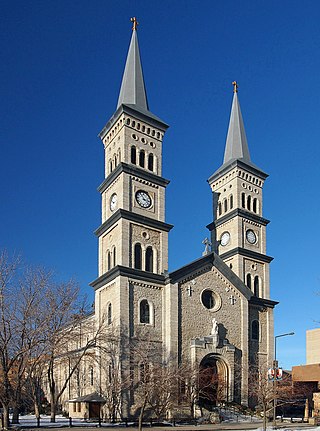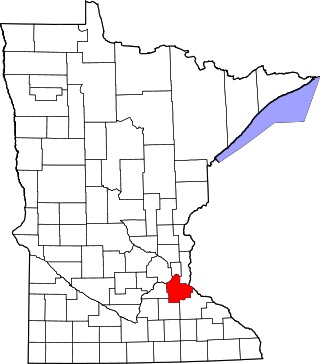
The Cathedral of Saint Paul is a Roman Catholic cathedral in the city of Saint Paul, Minnesota. It is the co-cathedral of the Archdiocese of Saint Paul and Minneapolis, along with the Basilica of Saint Mary in Minneapolis. One of the most distinctive cathedrals in the United States, it sits on Cathedral Hill overlooking downtown Saint Paul and features a distinctive copper-clad dome. It is dedicated to Paul the Apostle, who is also the namesake of the City of Saint Paul. The current building opened in 1915 as the fourth cathedral of the archdiocese to bear this name. On March 25, 2009, it was designated as the National Shrine of the Apostle Paul by the United States Conference of Catholic Bishops. It is the third-largest Catholic cathedral and sixth-largest church in the United States.

The Basilica of Saint Mary is a Roman Catholic minor basilica located on its own city block along Hennepin Avenue between 16th and 17th Streets in downtown Minneapolis, Minnesota. It was the first basilica established in the United States. The Basilica of Saint Mary is the co-cathedral of the Roman Catholic Archdiocese of Saint Paul and Minneapolis.

The Church of Saint Stephen is a historic Roman Catholic church in the Whittier neighborhood of Minneapolis in the U.S. state of Minnesota. This neighborhood is where entrepreneurs and businessmen built their mansions in the modern-day Washburn-Fair Oaks Mansion District. The building was built with sandstone, brick, concrete, and copper in 1889–1891.

The Church of the Assumption Catholic Church was dedicated in 1874 and is the oldest existing church in Saint Paul. It is located at 51 West Seventh Street, in downtown Saint Paul. The building is listed on the National Register of Historic Places.

This is a list of the National Register of Historic Places listings in Dakota County, Minnesota. It is intended to be a complete list of the properties and districts on the National Register of Historic Places in Dakota County, Minnesota, United States. Dakota County is located in the southeastern part of the U.S. state of Minnesota, bounded on the northeast side by the Upper Mississippi River and on the northwest by the Minnesota River. The locations of National Register properties and districts for which the latitude and longitude coordinates are included below, may be seen in an online map.

The Church of Saint Agnes is a Catholic church of the Archdiocese of Saint Paul and Minneapolis. The parish was founded in 1887 and the current church building was completed in 1912 and listed on the National Register of Historic Places in 1980.

The Church of Saint Casimir is a Roman Catholic church building built in 1904 in the Beaux-Arts style in Saint Paul, Minnesota, United States. It is listed on the National Register of Historic Places. The church was founded to serve the needs of Polish American immigrants.

Saint Paul is the second largest city in the U.S. state of Minnesota, the county seat of Ramsey County, and the state capital of Minnesota. The origin and growth of the city were spurred by the proximity of Fort Snelling, the first major United States military installation in the area, as well as by the city's location on the northernmost navigable port of the Upper Mississippi River.

The Church of St. Wenceslaus is a Catholic church in New Prague, Minnesota, United States, constructed in 1907. The church is flanked by a 1908 rectory and a 1914 parochial school, and the three-building complex is listed on the National Register of Historic Places for its association with the Czech American settlement of south-central Minnesota.

Seton Hill Historic District is a historic district in Baltimore, Maryland. It was listed on the National Register of Historic Places in 1975.

St. Peter's Roman Catholic Church in Harpers Ferry, West Virginia occupies a prominent location on the heights above Harpers Ferry. The original church was built in 1833 in a pseudo-Gothic style which it kept through the Civil War, being the only church in Harpers Ferry to escape destruction during the war. The church was extensively altered in 1896 in the then-popular Neo-Gothic style to produce the church seen today. The church commands a sweeping vista across the gorge of the Shenandoah River above its confluence with the Potomac River. The street along the side of the church building is part of the Appalachian Trail. A short trail leads from the church to Jefferson Rock. St. Peter's Church is a mission church of St. James in Charles Town. Mass is offered at the historic church every Sunday at 9:30 a.m.

St. Charles Borromeo Roman Catholic Church is a church located at the corner of Baldwin Avenue and St. Paul Avenue in Detroit, Michigan. The church address is 1515 Baldwin Street; ancillary buildings are located at 1491 Baldwin Street (Rectory) and 1480 Townsend Street. The complex was listed on the National Register of Historic Places in 1989.

The Washington Street Arts Center is a historic building at 202 Washington Street in Vermillion, South Dakota. It was originally built as the parish church of St. Agnes Catholic Church and was added to the National Register of Historic Places in 1995.

Church of Sts. Peter and Paul—Catholic is a historic church building on State Street in Gilman, Minnesota, United States. It was built in 1930 to serve a Polish-American congregation and designed in the Beaux Arts style by the Minneapolis architectural firm of Cordell & Olson. The first church was a log structure in 1872. It was known as the church of St. Wenceslas. Then a new church was built in the 1880s and was a frame structure known as St. Casimir's Church. The old log church was converted into classrooms. A new school building was built in 1909 and is present today. St. Casimir's church was destroyed by fire in 1891. A new and larger frame building was constructed for the new church. This church building stood north of the present brick building. The school building was completed in 1909. Fr. Vincent Wotzka as pastor had a brick rectory built in 1924. It was also designed by Cordelia and Olson. Sometime during these early years, the name of the parish was changed to Saints Peter and Paul. No reason has been found for the change. The church complex was added to the National Register of Historic Places in 1982.

The Church of St. Hubertus is a historic Catholic church in Chanhassen, Minnesota, United States, built in 1887. It was listed on the National Register of Historic Places in 1982 for having local significance in the themes of "community planning and development" and "exploration/settlement". It was nominated for symbolizing the Franciscan brotherhood that platted and grew the German Catholic settlement that became Chanhassen.

The Church of St. Mary, formerly the Church of St. Boniface, was a historic Roman Catholic church in Melrose, Minnesota, United States. The church and the adjacent 1907 rectory were listed together on the National Register of Historic Places in 1993 for having local significance in the themes of European ethnic heritage and social history. The property was nominated to the Register as a manifestation of the importance of ethnic parishes in the cultural and religious life of Minnesota's rural German American populace in the 19th and early 20th centuries.

The historic Church of St. Joseph is a church in Browerville, Minnesota, United States. It was built from 1908 to 1909 by a community of Polish immigrants that had established itself in the area from 1870 to 1900. The building was listed on the National Register of Historic Places as Church of St. Joseph—Catholic in 1985 for its local significance in the themes of architecture, exploration/settlement, and religion. It was nominated for its unifying central role in an immigrant community.

The Church of St. Michael is a historic Roman Catholic church building in St. Michael, Minnesota, United States, constructed in 1890. It was listed on the National Register of Historic Places in 1979 for having local significance in the themes of architecture, exploration/settlement, and religion. It was nominated for its status as the dominant architectural feature and the religious and social center of a German Catholic community.
Charles Albert Hausler was an American architect. Over his long career he had a major impact on the built environment of Saint Paul, Minnesota. As the first person to hold the office of city architect, he designed many public buildings, including Saint Paul's three Carnegie libraries. He also designed churches, commercial buildings, and homes in a variety of styles, including Neoclassical, Prairie School, and Art Deco.

Christ Lutheran Church on Capitol Hill is a congregation of the Evangelical Lutheran Church in America (ELCA) in the Thomas-Dale neighborhood of Saint Paul, Minnesota, United States.

























